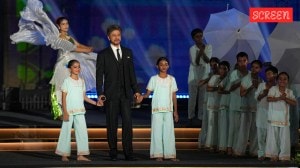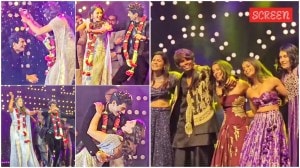Click here to follow Screen Digital on YouTube and stay updated with the latest from the world of cinema.
The Great Indian Kapil fiasco: After Atlee jibe, Kapil Sharma needs to rethink his jokes
Kapil Sharma’s conversation with Atlee ruffled feathers on social media. It’s surprising how over a decade, the format’s unapologetic classism and misogyny has largely gone unquestioned.
 Atlee wants the government to support him. (Photo: The Great Indian Kapil Show/Instagram)
Atlee wants the government to support him. (Photo: The Great Indian Kapil Show/Instagram)Will the controversy around Kapil’s conversation with Jawan director Atlee finally force the comedian to rethink his jokes?
Kapil Sharma has millions of fans around the country, or even the world perhaps. I have never been one of them. I just couldn’t laugh when the stand-up comedian turned TV host and his cast of comics spent episode after episode trying to extract laughs by humiliating women, old women, fat people, men crossdressing as women or mimicking Bollywood stars.
Given the fact that so much of the humour of Kapil’s show is derived from comments and digs at people’s appearances, it was surprising to see that Kapil’s conversation with Atlee ruffled feathers on social media, with netizens calling his question to the Jawan director inappropriate, and even racist.
View this post on Instagram
To recap, Kapil commented on the fact that Atlee has achieved success at a young age and said that he doesn’t ‘look’ like an established producer-director. He added, “But, when you get to meet a star for the first time, do they ask, where is Atlee?” Atlee kept his composure and replied, “In a way I understood your question. I’ll try to answer. I’m actually very thankful to AR Murugadoss sir because he produced my first film. He asked for a script, but he didn’t see how I was looking or whether I’m capable of it or not. But, he loved my narration. I think the world should see that. We should not judge by appearance. You have to judge by your heart.” It seems that more than Kapil’s question, Atlee’s response, where he implied that Kapil had commented on his appearance or skin tone has stoked the controversy. Responding to a tweet on social media which accused him of commenting on Atlee’s looks, Kapil has offered a clarification and said, “Dear sir, can you pls explain to me where n when I talked about looks in this video ? pls don’t spread hate on social media thank you. (guys watch n decide by yourself, don’t follow anybody’s tweet like a sheep).”
Though the question and the filmmaker’s response will be dissected in the days to come, the more pertinent question here is, why did Kapil think it necessary to ask any question, whether direct or indirect, about Atlee’s appearance in the first place? Perhaps because this is not the first time he or the other cast members have taken the liberty to pass personal comments or take jibes at a person’s appearance. When actor Nawazuddin Siddiqui appeared on Kapil’s show alongside Shah Rukh Khan to promote the film Raees, Kapil passed a comment saying that if he or Nawazuddin were the lead actors of the film, the title would have been Dhanda Gareeb Ka or Udhar Ki Zindagi, and not Raees which means rich. In the same episode, Sunil Grover and Kiku Sharda performed a sketch where Sharda was dressed as a female nurse. Grover’s character comments about how he had only a small amount of alcohol but stuffed a container of it into Sharda, mocking Sharda’s weight.
Kapil’s comments on his co-star Sumona Chakravarti’s lips in another episode had left her deeply upset. Speaking to a podcast host last year the actor said, “I remember Archana (Archana Puran Singh) sat with me and said ‘why are you upset?’ I said ‘They’ve made fun of my mouth and my lips and everything, and then I didn’t forget the lines he forgot and he said something off-script. I’m not a stand-up comedian; I can’t just come up with funny jokes like that.” Kapil is also notorious for ‘flirting’ with his female guests and commenting on their ‘beauty’. In an episode featuring journalist Sweta Singh as a guest, Kapil welcomed her with comments like, “Sweta, you’ve created a revolution in news. Earlier, only old people used to watch the news, now all young men watch it because of you. Even when you talk about drought, it feels like there is monsoon.” Not only were his comments sexist and borderline vulgar, they seemed to imply that Sweta’s success as a journalist was simply because of how she looked and dressed.
It’s surprising how over a decade, the format’s unapologetic classism and misogyny has largely gone unquestioned. Maybe because Kapil’s show is merely doing what Hindi cinema has been doing for years. Though directors and writers have become more sensitive in the recent past, sexism, body shaming, racism and demeaning those with speech impediments, disabilities or certain sexual orientations has been the means to generate humour in Hindi
cinema for decades. Additionally, stereotyping entire communities and linguistic groups and reducing them to exaggerated gestures and accents is another trope that refuses to go away. Though there have been exceptions, humour in mainstream cinema has largely been derived from punching down and mocking those who don’t look or function the way ‘normal’ people are supposed to. The writing on Kapil’s shows over the years is just one part of the problem. The larger problem is that millions of people across the country and now the world, thanks to Netflix, are sitting in their homes laughing at yet another man cross dressing as a woman, or a fat man being laughed at about his weight. There seems to be a shared vocabulary of humour and deep rooted biases, which gives shows like these the permission to keep recycling the same tropes and using the same regressive thought process in its content.
Writer and columnist Erma Bombeck said, “There is a thin line that separates laughter and pain, comedy and tragedy, humour and hurt.” Creating humour through an astute observation of human follies or the ‘truth stranger than fiction’ scenarios that we find ourselves in, requires talent, intelligence and an ability to see the mirth in our existential dilemmas. After flogging the same format from 2013, perhaps Kapil Sharma and his team needs to rethink what or whom they want to make fun of in the years to come. Also as audiences, we need to introspect and ask ourselves; don’t we deserve better, or if nothing else something different? If we laugh at bullying or misogyny masked as humour, what does that make us?




- 01
- 02
- 03
- 04
- 05






























